30.11.16
Revolutionary movement in Europe and Asia after World War I

Causes of revolutions
The trials that befell the peoples in the First World War, dissatisfaction with the policies of the victorious powers in the defeated, colonial and dependent countries became the reason for the rise of the revolutionary movement in many parts of the world. The most large-scale revolutionary events took place in 1917 in Russia, which became a center of support for revolutionary forces in other countries.
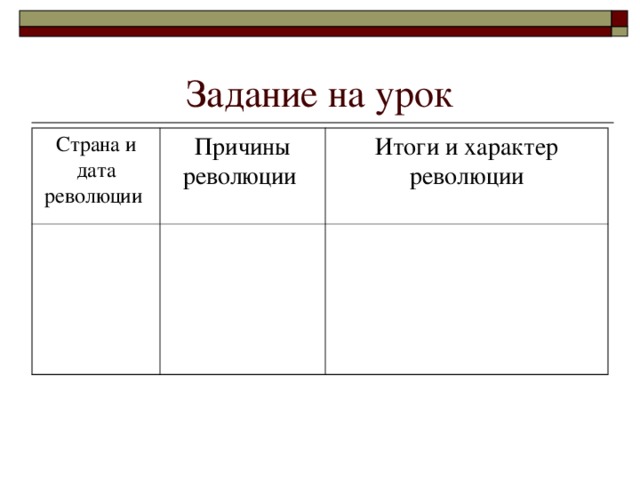
Lesson assignment
Country and date of revolution
Causes of the revolution
Results and nature of the revolution
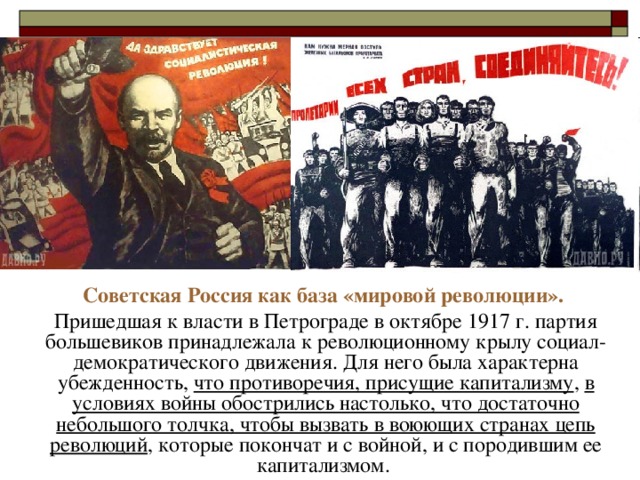
Soviet Russia as the base of the “world revolution”.
The Bolshevik Party, which came to power in Petrograd in October 1917, belonged to the revolutionary wing of the Social Democratic movement. He was characterized by conviction that the contradictions inherent in capitalism , in conditions of war they have become so aggravated that a small push is enough to cause a chain of revolutions in the warring countries, which will put an end to both the war and the capitalism that gave birth to it.

Comintern
Created in 1919, the Third Communist International, which included left-wing groups of the social democratic movement, organized into communist parties, became in the eyes of many leaders Soviet Russia forerunner of the world communist government. However, the events of 1919-1920 for all their inconsistency and ambiguity, they have by no means proven that “ world revolution"is on the agenda.
Women's demonstration for peace (1920s)
The hopes of the Comintern leaders for the rise of the revolutionary movement in the countries that won the First World War were not justified from the very beginning. The example of the violent seizure of power by the Bolsheviks and the subsequent bloody and destructive civil war showed the majority of the population of highly developed countries the danger of being carried away by revolutionary ideas. The movement of solidarity with Soviet Russia, which arose in the Entente powers, was pacifist in nature, its main demand was to give Russia the opportunity to decide its own destiny. True, in conditions when the Entente countries did not rule out intervention in the civil war in Russia, such solidarity was saving for the Russian Bolsheviks.

Revolution of 1918 in Germany
The Comintern placed great hopes on the deepening of the political and economic crisis in the countries that lost the first world war. Thus, in Germany, after the abdication of Kaiser Wilhelm II and the paralysis of power, following the example of Soviet Russia, bodies of people's self-government began to emerge - councils headed by Social Democrats. On November 10, 1918, the Council of Berlin created a new government - the Council of People's Representatives, which was headed by the leader of the Social Democratic Party of Germany F. Ebert.

The Social Democratic government proclaimed Germany a republic
and carried out a number of reforms.
- democratic freedoms were approved,
- class privileges were abolished,
- elections were scheduled for the Constituent National Assembly, which was to adopt a new constitution.
The All-German Congress of Soviets in December 1918 supported the course of the government of F. Ebert, aimed at establishing a bourgeois-democratic republic in Germany.
Council of People's Representatives. F. Scheidemann,
O. Landsberg, F. Ebert, G. Noske, R. Wissel.
Revolutionary soldiers and sailors at the Brandenburg Gate
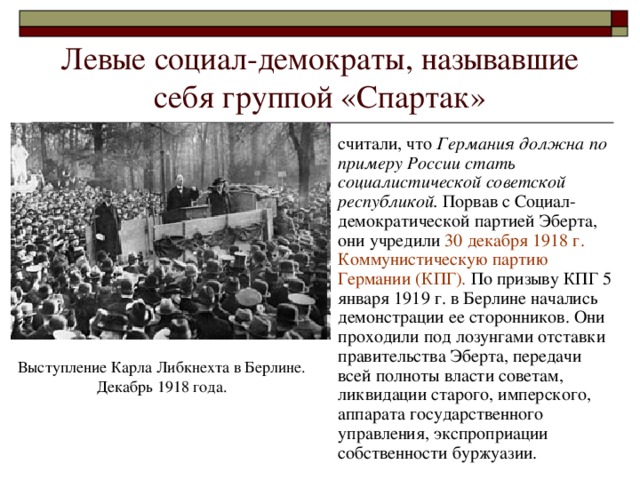
Left Social Democrats who called themselves the Spartak group
believed that Germany must follow the example of Russia to become a socialist Soviet republic. Breaking with Ebert's Social Democratic Party, they founded the Communist Party of Germany (KPD) on December 30, 1918. At the call of the KPD, on January 5, 1919, demonstrations by its supporters began in Berlin. They took place under the slogans of the resignation of the Ebert government, the transfer of full power to the soviets, and the liquidation of the old imperial apparatus government controlled, expropriation of the property of the bourgeoisie.
Speech by Karl Liebknecht in Berlin.
December 1918.
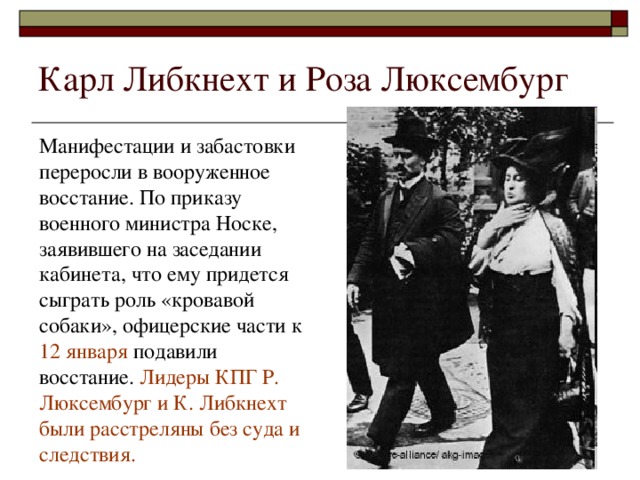
Karl Liebknecht and Rosa Luxemburg
Demonstrations and strikes grew into an armed uprising. By order of War Minister Noske, who stated at a cabinet meeting that he would have to play the role of a “bloody dog,” officer units suppressed the uprising by January 12. The leaders of the KKE R. Luxemburg and K. Liebknecht were shot without trial.

Bavarian Soviet Republic
In April 1919, the communists managed to seize power in the German state of Bavaria and proclaim a Soviet republic there. The formation of the Red Army began, but already in May, troops loyal to the government occupied the capital of Bavaria, Munich.

Weimar Republic
After the elections to the National Assembly, which the communists boycotted, the Social Democrats turned out to be the largest party faction (39% of seats). Together with centrist parties, they achieved the adoption of a constitution that proclaimed Germany is a democratic republic. The Constitution was called Weimar because the National Assembly met in the city of Weimar. F. Ebert became the President of the Weimar Republic.
Friedrich Ebert
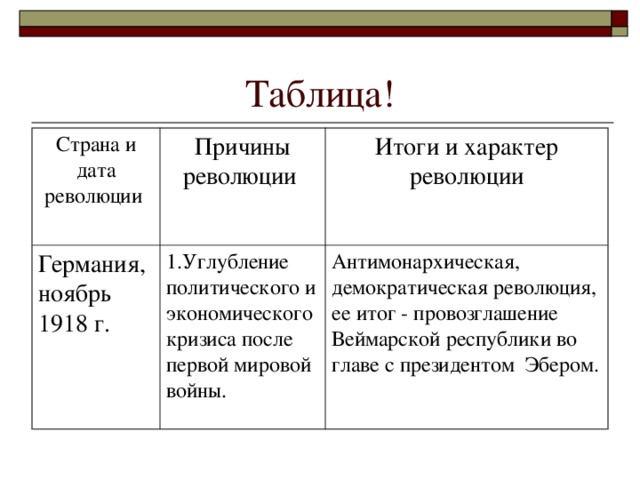
Country and date of revolution
Causes of the revolution
Germany, November 1918
Results and nature of the revolution
1.The deepening of the political and economic crisis after the First World War.
Anti-monarchical, democratic revolution, its result was the proclamation of the Weimar Republic led by President Eber.

Revolution of 1919 in Hungary
The revolutionary movement also failed in the Habsburg Empire, Austria-Hungary, which collapsed as a result of the war. The new states of Austria, Czechoslovakia and Hungary that emerged on its territory declared themselves republics. The revolutionary mass movement developed only in Hungary.
Republic! Poster by M. Biro. 1919
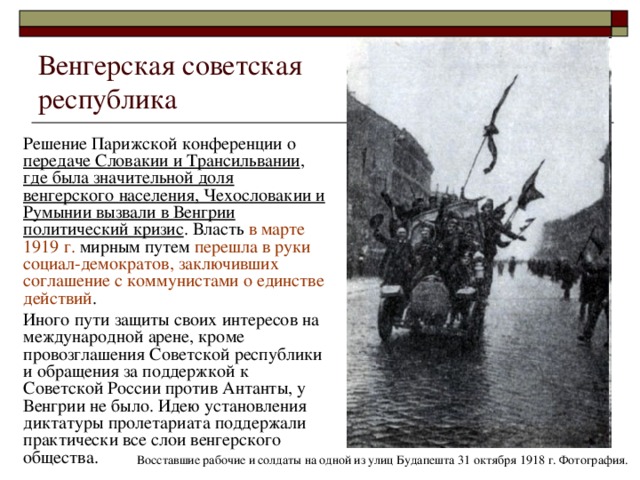
Hungarian Soviet Republic
The decision of the Paris Conference on transfer to Slovakia and Transylvania , where there was a significant proportion of the Hungarian population, Czechoslovakia and Romania caused a political crisis in Hungary. Power in March 1919 peacefully passed into the hands of the Social Democrats, who entered into an agreement with the Communists on unity of action.
Hungary had no other way to protect its interests in the international arena other than declaring a Soviet republic and seeking support from Soviet Russia against the Entente. The idea of establishing a dictatorship of the proletariat was supported by almost all layers of Hungarian society.
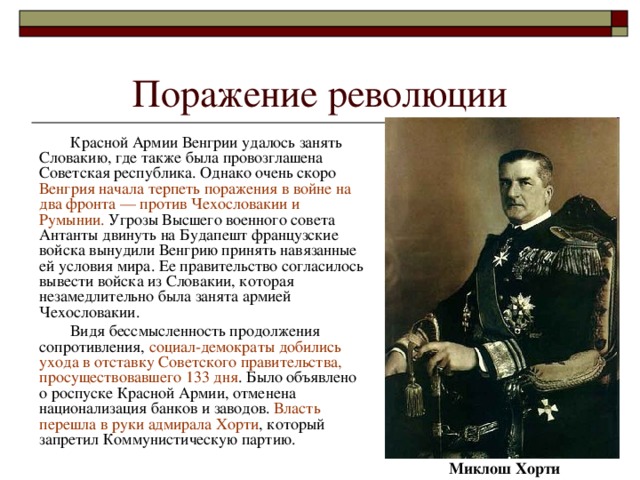
Defeat of the revolution
The Hungarian Red Army managed to occupy Slovakia, where the Soviet Republic was also proclaimed. However, very soon Hungary began to suffer defeats in a war on two fronts - against Czechoslovakia and Romania. Threats by the Entente Supreme Military Council to move French troops to Budapest forced Hungary to accept the peace terms imposed on it. Her government agreed to withdraw troops from Slovakia, which was immediately occupied by the Czechoslovak army.
Seeing the pointlessness of continuing resistance, the Social Democrats achieved the resignation of the Soviet government, which lasted 133 days. The dissolution of the Red Army was announced, and the nationalization of banks and factories was canceled. Power passed into the hands of Admiral Horthy, who banned the Communist Party.
Miklos Horthy
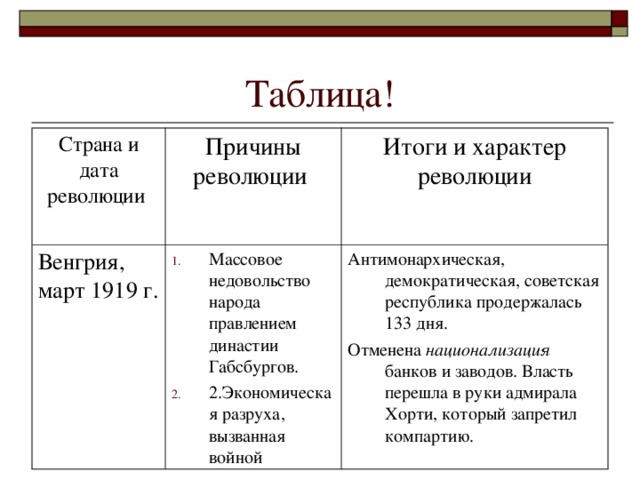
Country and date of revolution
Causes of the revolution
Hungary, March 1919
Results and nature of the revolution
- Massive discontent of the people with the rule of the Habsburg dynasty.
- 2.Economic devastation caused by the war
The anti-monarchical, democratic, Soviet republic lasted 133 days.
Canceled nationalization banks and factories. Power passed into the hands of Admiral Horthy, who banned the Communist Party.
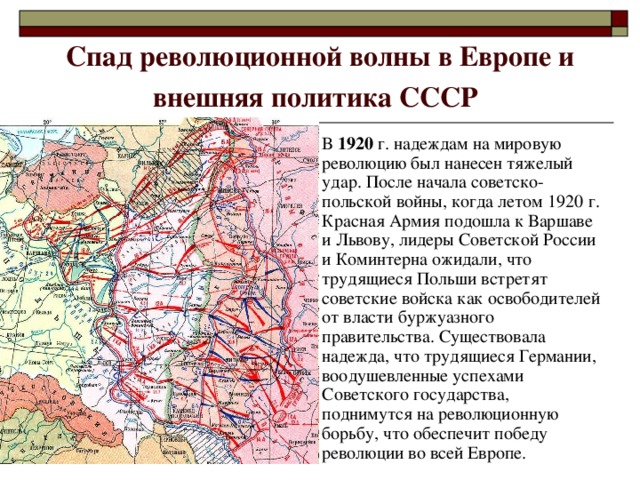
The decline of the revolutionary wave in Europe and the foreign policy of the USSR
IN 1920 hopes for a world revolution were dealt a heavy blow. After the outbreak of the Soviet-Polish War, when the Red Army approached Warsaw and Lvov in the summer of 1920, the leaders of Soviet Russia and the Comintern expected that the working people of Poland would meet Soviet troops as liberators from the power of the bourgeois government. There was hope that the working people of Germany, inspired by the successes Soviet state, will rise to the revolutionary struggle, which will ensure the victory of the revolution throughout Europe.
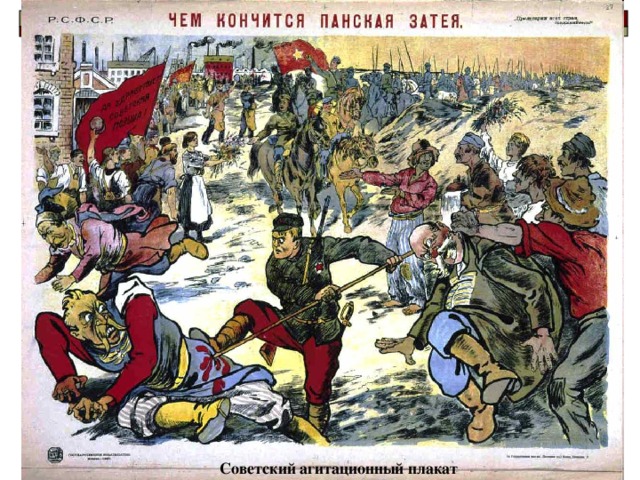
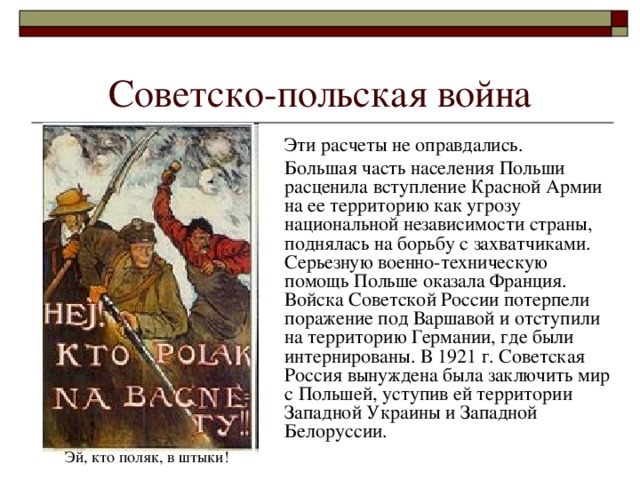
Soviet-Polish War
These calculations did not come true.
Most of the population of Poland regarded the entry of the Red Army into its territory as a threat to the national independence of the country and rose up to fight the invaders. France provided serious military-technical assistance to Poland. The troops of Soviet Russia were defeated near Warsaw and retreated to German territory, where they were interned. In 1921, Soviet Russia was forced to make peace with Poland, ceding to it the territories of Western Ukraine and Western Belarus.
Hey, who is Pole, with hostility!
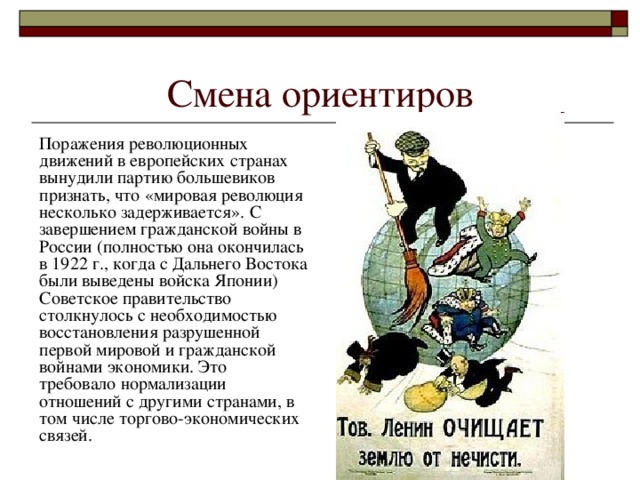
Changing landmarks
The defeats of the revolutionary movements in European countries forced the Bolshevik Party to admit that “the world revolution is somewhat delayed.” With the end of the civil war in Russia (it completely ended in 1922, when Far East Japanese troops were withdrawn) The Soviet government was faced with the need to restore the economy destroyed by the First World War and the Civil War. This required the normalization of relations with other countries, including trade and economic ties.

Royal debts
At conferences in Genoa and The Hague (1922), devoted to the problems of settling financial claims, the Soviet delegation proposed that the Entente countries, first of all, compensate for the damage caused to Russia by the intervention and economic blockade. No final decision was made. Settlement of the disputed issues was postponed given the complex economic situation Soviet state.
MM. Litvinov and V.V. Vorovsky - members of the Soviet
delegations at the conference in Genoa. Photo from 1922.
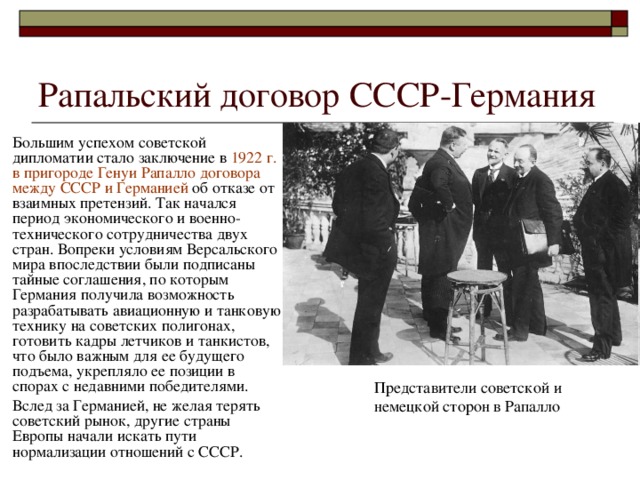
Treaty of Rapala USSR-Germany
A great success of Soviet diplomacy was the conclusion in 1922 in the suburb of Genoa of Rapallo of an agreement between the USSR and Germany on the renunciation of mutual claims. Thus began the period of economic and military-technical cooperation two countries. Contrary to the terms of the Treaty of Versailles, secret agreements were subsequently signed, according to which Germany received the opportunity to develop aviation and tank equipment at Soviet training grounds, train pilots and tank crews, which was important for its future rise and strengthened its position in disputes with recent victors.
Following Germany, not wanting to lose the Soviet market, other European countries began to look for ways to normalize relations with the USSR.
Representatives of the Soviet and
German parties in Rapallo

QUESTIONS AND TASKS
- How were the changes in the nature of power in Russia and the class approach of the Bolsheviks to issues reflected? foreign policy on international relations? By whom and for what purpose was the Communist International created?
- Why in Germany and Hungary in 1918-1919? have there been revolutions? What did these events have in common? What made them different? What impact did these revolutions and their defeat have on Russia?
- What echo did the revolutionary events and the civil war in Russia have in the world?
- Why in the 1920s? Has the USSR changed the direction of its foreign policy? What results have been achieved?
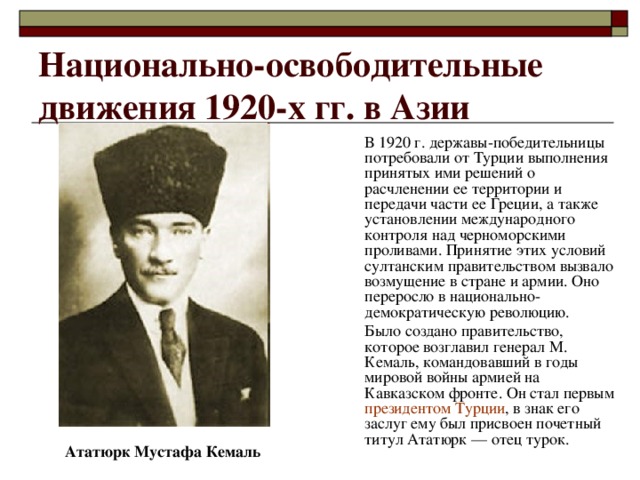
National liberation movements of the 1920s. in Asia
In 1920, the victorious powers demanded that Turkey implement the decisions they had made on the dismemberment of its territory and the transfer of part of it to Greece, as well as the establishment of international control over the Black Sea straits. The acceptance of these conditions by the Sultan's government caused outrage in the country and the army. It grew into a national democratic revolution.
A government was created, headed by General M. Kemal, who commanded the army on the Caucasian front during the World War. He became the first president of Turkey, and as a sign of his merits he was given the honorary title Ataturk - father of the Turks.
Ataturk Mustafa Kemal
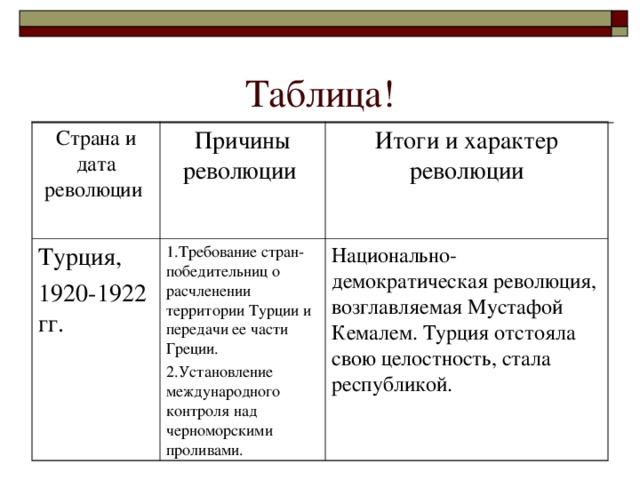
Country and date of revolution
Causes of the revolution
Results and nature of the revolution
1. The demand of the victorious countries for the dismemberment of the territory of Turkey and the transfer of part of it to Greece.
2. Establishment of international control over the Black Sea straits.
National democratic revolution led by Mustafa Kemal. Türkiye defended its integrity and became a republic.
Revolution in Iran
Iran became the arena of the revolutionary movement. During the war it was occupied by Russian and British troops. In 1919, Great Britain signed a treaty with the Shah of Iran, securing his status as a dependent country. In particular, it was assumed that British advisers would lead the Iranian army and government departments. This agreement became the cause of discontent in various sectors of Iranian society, including the clergy and merchants. Weakening central government caused a rise in separatist movements in many provinces of Iran, especially in the north of the country.
In 1921, the government palace in Tehran was captured military units, commanded by Lieutenant Colonel Reza Khan, who later became the Shah of Iran. The new government of Iran refused to ratify the treaty with England and established friendly relations with Soviet Russia. The signed Soviet-Iranian treaty established Iran's status as an independent state. Iran pledged not to allow its territory to be used for activities hostile to Russia. Otherwise, Russia had the right to send troops to Iran. This clause guaranteed Iran protection from military intervention by Great Britain, which was then considered a state hostile to Russia.
Reza Shah Pahlavi
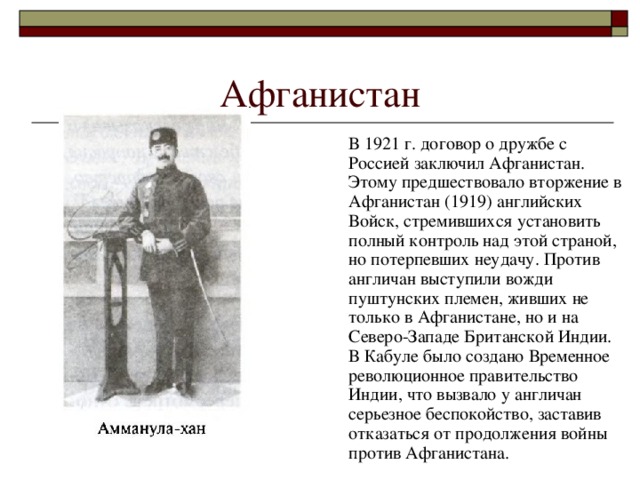
Afghanistan
In 1921, Afghanistan concluded a friendship treaty with Russia. This was preceded by the invasion of Afghanistan (1919) by British troops, who sought to establish complete control over this country, but failed. The leaders of the Pashtun tribes, who lived not only in Afghanistan, but also in the North-West of British India, opposed the British. The Provisional Revolutionary Government of India was created in Kabul, which caused serious concern among the British, forcing them to abandon the continuation of the war against Afghanistan.
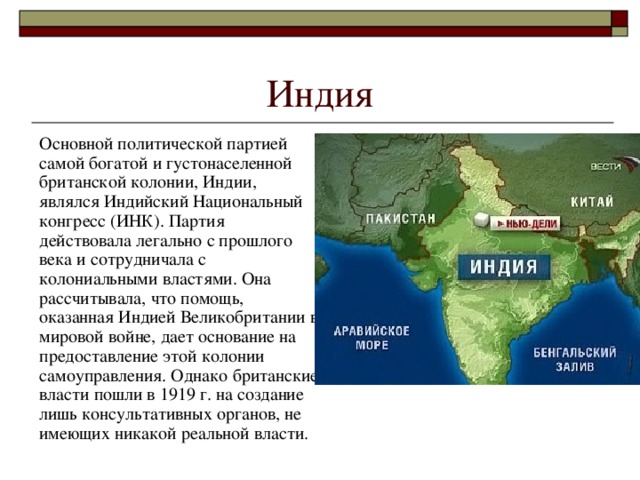
The main political party of the richest and most populous British colony, India, was the Indian National Congress (INC). The party operated legally since the last century and collaborated with the colonial authorities. She hoped that the assistance India provided to Great Britain in the World War provided grounds for granting self-government to this colony. However, in 1919 the British authorities decided to create only advisory bodies that had no real power.
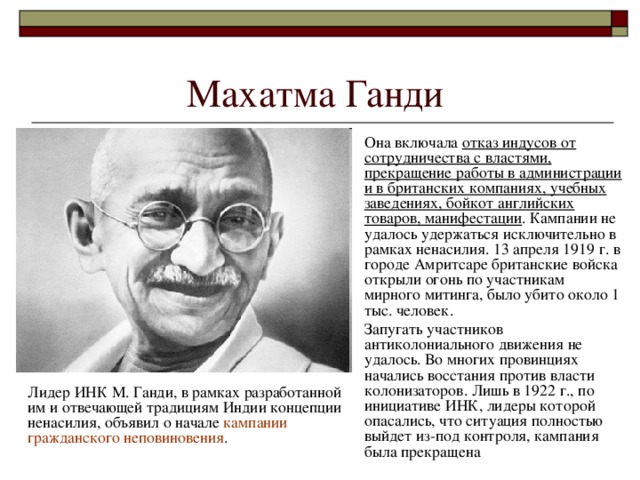
Mahatma Gandhi
It included refusal of Indians to cooperate with the authorities, termination of work in the administration and in British companies, educational institutions, boycott of British goods, demonstrations. The campaign failed to stay within a purely nonviolent framework. On April 13, 1919, in the city of Amritsar, British troops opened fire on participants in a peaceful rally, killing about 1 thousand people.
It was not possible to intimidate the participants in the anti-colonial movement. In many provinces, uprisings began against the power of the colonialists. Only in 1922, on the initiative of the INC, whose leaders feared that the situation would get completely out of control, was the campaign stopped
INC leader M. Gandhi, within the framework of the concept of non-violence developed by him and in keeping with the traditions of India, announced the start of a campaign of civil disobedience.
Gandhi Mahatma (1869-1948) - leader of the Indian national liberation movement.
“Only when a person scrupulously follows the laws of society is he able to judge which laws are good and just and which are unjust and vicious. Only then does he have the right to civil disobedience to certain laws in precisely defined circumstances. We are soldiers of non-violence, ready to give our lives if circumstances require it. It is true that to some extent non-violence is effective even in the hands of the weak. And in this case, this weapon will be useful to us. But if someone uses non-violence to disguise his weakness or helplessness, this is cowardice. Such a person works on two fronts, he cannot live like a person, although, of course, he cannot become a devil . It's a thousand times better when we die trying to use force. The bold use of physical force is far preferable to cowardice."(Anthology of world political thought. M, 1997. T 2. P. 148-152)
Determine from the fragment the main views of M. Gandhi on the ways of fighting for the independence of India. Do you share the author's belief in the “power of nonviolence”? Explain your judgments.
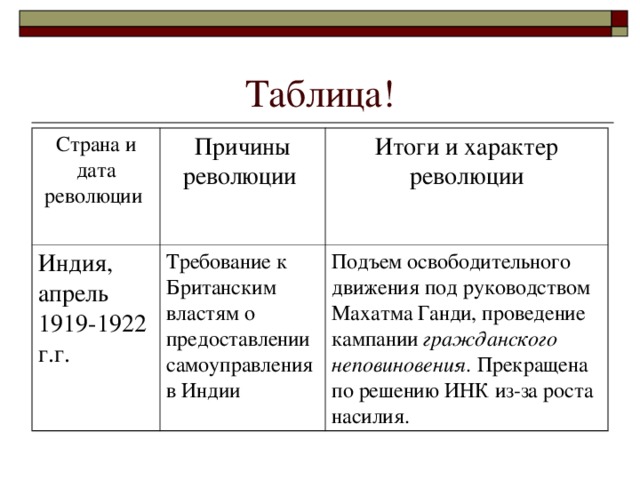
Country and date of revolution
Causes of the revolution
India, April 1919-1922
Results and nature of the revolution
Demand for British authorities to grant self-government in India
The rise of the liberation movement under the leadership of Mahatma Gandhi, the campaign civil disobedience. Stopped by decision of the INC due to increased violence.

The scene of the largest revolutionary events in the 1920s. became China
The decisions of the Washington Conference, which returned China to its position at the beginning of the century - a dependent country with “open doors” to foreigners, caused the rise of the national movement. The Communist Party, created in China with the support of the Comintern, together with the bourgeois-nationalist Kuomintang, created a united anti-imperialist front. The formation of the National Revolutionary Army (NRA) began, to the creation of which the USSR made a major contribution. The NRA was equipped with Soviet weapons, its ranks included military instructors and volunteers from the USSR, led by the Soviet military leader V.K. Blucher.
Chief military adviser Vasily Blyukher
and Kuomintang Party leader Chiang Kashi
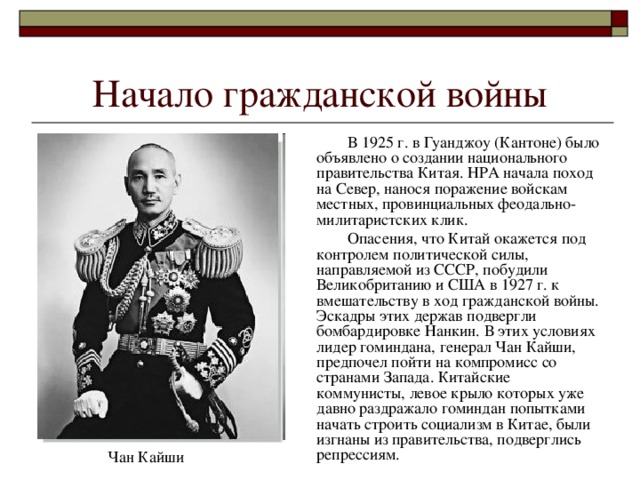
Beginning of the Civil War
In 1925, the creation of a national government of China was announced in Guangzhou (Canton). The NRA began a campaign in the North, defeating the troops of local, provincial feudal-militarist cliques.
Fears that China would be under the control of a political force directed from the USSR prompted Great Britain and the United States to intervene in the civil war in 1927. The squadrons of these powers bombed Nanking. Under these conditions, the leader of the Kuomintang, General Chiang Kai-shek, chose to compromise with Western countries. The Chinese communists, whose left wing had long irritated the Kuomintang with attempts to begin building socialism in China, were expelled from the government and subjected to repression.
Chiang Kai-shek

Civil War
A long-term civil war began in China, which continued intermittently until 1949. Those parts of the NRA in which there was a strong influence of communists and Soviet advisers became the basis of the Chinese Red Army. In 1931, the creation of the workers' and peasants' government of the Chinese Soviet Republic was proclaimed, headed by the leader of the Communist Party Mao Zedong. It controlled the northern regions of the country, relying on the support of the USSR.

Country and date of revolution
Causes of the revolution
China, 1923-1949
Results and nature of the revolution
The decision of the Washington Conference returning China to the status of a dependent country
The rise of the national liberation movement, the creation of the NRA (national revolutionary army) and the national government in 1925. The coup of Chiang Kai-shek in 1927 and the expulsion of the communists from the government. Civil war in China with interruptions until 1949. The struggle of the communists led by Mao Zedong for the Sovietization of the country.
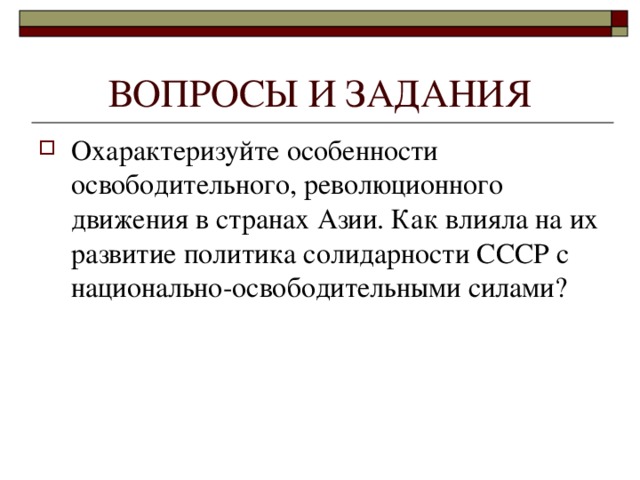
QUESTIONS AND TASKS
- Describe the features of the liberation and revolutionary movements in Asian countries. How did the USSR’s policy of solidarity with the national liberation forces influence their development?
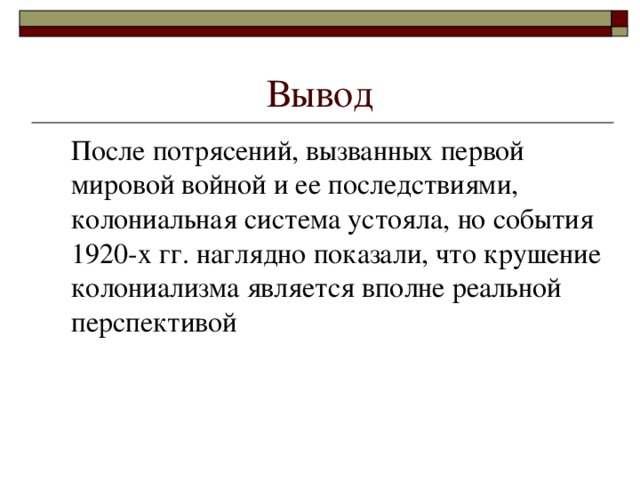
After the turmoil caused by the First World War and its consequences, colonial system survived, but the events of the 1920s. clearly showed that the collapse of colonialism is a very real prospect
First stage
The war began with the assassination of Franz Ferdinand (heir to the Habsburg Empire) and his wife by the Serbian nationalist terrorist Gavrilo Princip. The murder led to a conflict between Serbia and Austria, and, in fact, served as the reason for the start of a war that had been brewing for a long time in Europe. Austria was supported by Germany in this war. This country entered the war with Russia on August 1, 1914, and two days later - with France; further, the German army broke into the territory of Luxembourg and Belgium. The opposing armies advanced towards the sea, where the line of the Western Front eventually closed. For some time, the situation here remained stable, and France did not lose control of its coast, which German troops unsuccessfully tried to capture. In 1914, namely in mid-August, the Eastern Front opened: here the Russian army attacked and quickly captured territories in eastern Prussia. The Battle of Galicia, victorious for Russia, took place on August 18, temporarily putting an end to the violent clashes between the Austrians and Russians.
Serbia recaptured Belgrade, which had previously been captured by the Austrians, after which no particularly active battles followed. Japan also opposed Germany, seizing its island colonies in 1914. This secured the eastern borders of Russia from invasion, but it was attacked from the south by the Ottoman Empire, which acted on the side of Germany. At the end of 1914, she opened the Caucasian Front, which cut off Russia from convenient communications with allied countries.
Second phase
Intensified Western Front: Here in 1915, fierce fighting between France and Germany resumed. The forces were equal, and the front line remained almost unchanged at the end of the year, although both sides suffered significant damage. On the Eastern Front, the situation changed for the worse for the Russians: the Germans made the Gorlitsky breakthrough, recapturing Galicia and Poland from Russia. By autumn, the front line had stabilized: now it ran almost along the pre-war border between the Austro-Hungarian Empire and Russia.
In 1915 (May 23), Italy entered the war. At first, she declared war on Austria-Hungary, but soon Bulgaria also joined the hostilities, opposing the Entente, which ultimately led to the fall of Serbia.
In 1916, the Battle of Verdun took place, one of the largest battles in this war. The operation lasted from late February to mid-December; During this confrontation between German forces, who had lost 450,000 soldiers, and Anglo-French forces, who had suffered 750,000 casualties, the flamethrower was used for the first time. On the Western Russian Front, Russian troops made the Brusilov breakthrough, after which Germany transferred most of its troops there, which played into the hands of England and France. Fierce battles were also fought on the water at this time. Thus, in the spring of 1916, the major Battle of Jutland took place, strengthening the positions of the Entente. At the end of the year, the Quadruple Alliance, having lost its dominant position in the war, proposed a truce, which the Entente rejected.
Third stage
In 1917, the United States joined the Allied forces. The Entente was close to victory, but Germany held a strategic defense on land, and also tried to attack British forces with the help of submarine fleet. Russia in October 1917, after the Revolution, had almost completely emerged from the war and was absorbed in internal problems. Germany liquidated the Eastern Front by signing an armistice with Russia, Ukraine and Romania. In March 1918, the Treaty of Brest-Litovsk was concluded between Russia and Germany, the terms of which turned out to be extremely difficult for Russia, but this treaty was soon annulled. The Baltic states, part of Belarus and Poland were still under Germany; The country transferred its main military forces to the west, but, together with Austria (the Habsburg Empire), Bulgaria and Turkey (Ottoman Empire), it was defeated by the Entente forces. Finally exhausted, Germany was forced to sign the Act of Surrender - this happened in 1918, on November 11. This date is considered the end of the war.
General history. Recent history. 9th grade Shubin Alexander Vladlenovich
§ 3. Revolutionary wave after the First World War
Formation of new nation states
One of the results of the First World War was the collapse of the Russian, German, Austro-Hungarian and Ottoman empires. The revolution of 1917 turned Russia into a republic and caused the rise of national movements. After the Bolsheviks came to power, many representatives of national movements opposed them. Following the previously proclaimed principle of “the right of nations to self-determination up to and including secession,” the government of V.I. Lenin granted independence to Finland, Poland, Ukraine, the Baltic and Transcaucasian countries. At the same time, the Bolsheviks hoped to bring communists to power in these countries and, in fact, link them again with Russia. This plan was a success in relation to Ukraine and the countries of Transcaucasia. In Finland, the communist uprising in January–March 1918 was suppressed by the joint actions of the Finnish army, commanded by General Karl Mannerheim, and the German interventionists.
Comrade Lenin cleanses the earth of evil spirits. Poster by artists M. Cheremnykh and V. Denis. 1920
The rulers of Poland tried to include the territory of Ukraine into their state, but their attack on Kyiv in 1920 failed. However, the Soviet-Polish war led to the defeat of the Red Army near Warsaw, and part of the territories inhabited by Ukrainians and Belarusians became part of Poland. Thanks to the help of German and White Guard troops, Estonia, Latvia and Lithuania also managed to defend their independence.
In October 1918, the democratic revolution began in Austria-Hungary. In Vienna, the Social Democrats seized power, and in the capitals of the national provinces - the leaders of local national democratic parties, who declared the independence of their countries. As a result, Austria became a small German-speaking republic. At the same time, the temporary national assembly of the Czech Republic and Slovakia proclaimed the creation of the Republic of Czechoslovakia. Freed from Austro-Hungarian rule, the South Slavic peoples united with Serbia and Montenegro into the Kingdom of Serbs, Croats and Slovenes.
November Revolution in Germany
After the breakthrough of the German front in 1918, Hindenburg was going to throw the German fleet into battle. However, in response to this order, the sailors in Kiel rebelled and marched on Berlin. They were supported by masses of war-weary workers. Wilhelm II fled the country, Reichstag deputies proclaimed Germany a republic. The fall of the German Empire led to a socio-political revolution and opened up the possibility of choosing a further path of development for the devastated and ruined country. Bodies of workers' self-government - councils - began to be created throughout the country. As in Russia in the spring of 1917, the Social Democrats received a majority in the soviets. They belonged to the moderate Social Democratic Party of Germany (SPD) and the more radical Independent Social Democratic Party of Germany (NSPD). Both parties advocated for the socialist system, but they saw the ways of its establishment differently. The SPD advocated more moderate, gradual actions, while the NSDPG advocated more decisive ones. The Berlin Council transferred power to the Council of People's Representatives (government) led by the Social Democrat Friedrich Ebert. The government immediately allowed free activity trade unions, strikes and introduced an 8-hour working day.
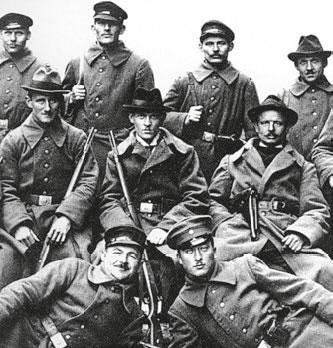
Revolting soldiers and workers. Berlin. 1919
The fate of the country was to be decided by the Constituent Assembly, whose elections were scheduled for January 1919. Political parties launched an election campaign. The SPD advocated a democratic parliamentary republic, the protection of workers' social rights, and equal agreements between trade unions and entrepreneurs (social partnership). But all this was conceived while maintaining capitalist relations. The leaders of the NSDPD, including the veteran of social democracy Karl Kautsky, believed that already in the conditions of the ongoing revolution it was possible to create the foundations of new socialist relations: develop workers’ self-government, combine parliamentary democracy with Soviet democracy. The NSDPD included the Spartak Union, led by Karl Liebknecht and Rosa Luxemburg, who advocated Soviet power and the transition from the bourgeois revolution to the socialist one. In December 1918, the Spartacists left the NSDPD and created the Communist Party of Germany (KPD).
Revolution in Germany
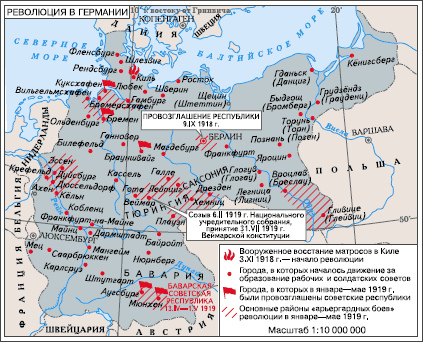
Name the most important centers of the German revolution. Show what their weakness was from a military point of view.
In January, a spontaneous demonstration of sailors and workers escalated into street battles in Berlin. The Spartacists' supporters were defeated. Although Liebknecht and Luxemburg did not take part in the uprising, they were captured by conservative officers and killed.
Remember the differences between parliamentary and Soviet principles of organizing power.
Weimar Republic and the end of the revolution in Germany
Social Democrats, liberals and conservatives won the elections to the Constituent Assembly. The communists did not participate in the elections. The meeting began work in February 1919 in the city of Weimar, far from the radical working masses. The constitution he adopted and the republic itself were called Weimar. Ebert was elected as the first president. Germany became a federal republic because its individual states were given greater rights. The government of the new state was to be formed by a chancellor appointed by the president. Government actions had to be approved by the Reichstag (parliament). This system, based on the principle of balance of power, could easily lead to paralysis of government in the event of a conflict between the president and the parliamentary majority. The Constitution enshrined democratic freedoms - speech, assembly, strikes, etc. But in the event of a threat to “public security,” the president could suspend these freedoms by decree.
![]()
Caricature of the Weimar Republic
The Constitution could not improve the socio-economic situation in the country, the revolution continued. In March 1919, the communists and the hungry workers who supported them rebelled, and civil war broke out. But the Communist Party, which tried to create Soviet republics in the lands, did not have strong and famous leaders. Moderate Social Democrats were more popular; they united with conservatives and managed to attract experienced officers to their side. Volunteer military detachments arose that suppressed outbreaks of uprisings. In May, the last Soviet republic, in Bavaria, fell.
After the defeat of the left, the forces that wanted to restore the previous, pre-revolutionary order rose up. In the spring of 1920, a division of reactionary volunteers entered Berlin. In response, Berliners launched a general strike, and the rebellion was crushed. These events went down in history by the name of one of the organizers as the Kapp Putsch.
In 1921 and 1923 The communists again attempted to overthrow the republic and establish Soviet power. But now their influence was already small. In October 1923, the last communist uprising led by Ernst Thälmann was suppressed in Hamburg. At the same time, leftist governments in the states of Thuringia and Saxony were dispersed. The revolution is over.
Soviet power in Hungary
After the defeat of Austria-Hungary in the war, Hungary was considered one of the defeated countries and had to give up all territories inhabited predominantly by Slavs and Transylvania, inhabited by Hungarians and Romanians. The Karolyi government did not want to make peace on such terms and transferred power to the left-wing Social Democrats. They, in turn, decided to rely on the help of Soviet Russia and for this they united with the communists into a socialist party. The new government proclaimed Soviet power. It was headed by the Social Democrat Sandor Gorbai, and the Communist Bela Kun became the People's Commissar for Foreign Affairs. The new government refused to recognize the states that arose during the collapse of Austria-Hungary, which immediately led to conflict with Czechoslovakia, Romania and other countries. In April 1919, with the support of the Entente, the armies of these states invaded Hungary.

Bela Kun and other leaders of the Hungarian Revolution
The Soviet government proclaimed an 8-hour working day, introduced worker insurance and free education. Factories and banks were transferred to the state. In the hands of the state, production could not develop effectively, but the workers felt like masters of the country and fought bravely at the front. In May, the Red Army stopped the enemy advance and invaded Slovakia. In June the Slovak Soviet Republic was proclaimed. The Hungarian Red Army hoped to unite with the Red Army of the RSFSR and spread the “world revolution” throughout Europe. But peasant uprisings in Ukraine and Denikin’s offensive did not allow the troops of Soviet Russia to provide assistance to the Hungarians. In July, Romanian troops again launched an offensive against Hungarian Republic. They were supported by Hungarian counter-revolutionaries led by Miklos Horthy. In August 1919, the Soviet government resigned and its leaders left the country. In 1920, power passed to Horthy, who established an anti-communist dictatorship. Hungary made peace with the Entente on unfavorable terms.
Revolution in Hungary
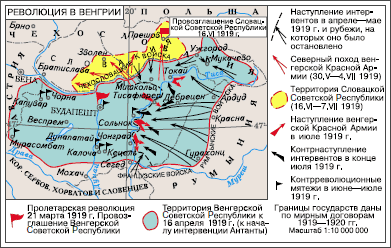
Show in which direction the Hungarian Red Army came closest to the forces of Soviet Russia. Show on the map how the position of the Hungarian Soviet Republic would change if the armies of these two states united.
Revolutionary movement and the formation of the Comintern
In 1917–1923 Revolutionary events swept many countries around the world. In September 1920, Italian workers began a general strike and seized factories. Moreover, in some factories, workers were able to establish production without capitalists, that is, take a step towards socialism. But still, the proletarian movement was poorly organized; the Social Democrats did not support it. After concessions from the entrepreneurs, the workers returned the factories to them.
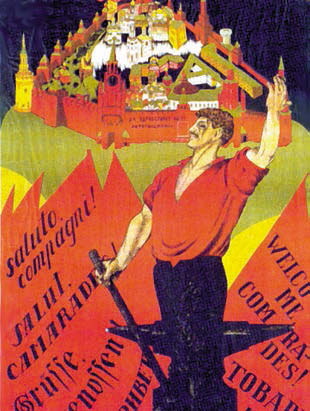
Poster dedicated to the creation of the Comintern
A wave of protest against imperialism swept through colonies and semi-colonies - India, China, Afghanistan, Egypt, Korea. The revolution in Mexico continued. In 1917, a democratic constitution was adopted here and agrarian reform began - the lands of the landowners were transferred to the peasants. It seemed to many socialists that a world revolution was coming, capable of overthrowing the capitalist system throughout the Earth. But the world organization of socialists did not exist at that time. The Second International disintegrated at the outbreak of the World War because the Social Democratic leaders supported the war efforts of their governments and thus opposed their comrades in other countries. In 1919, the Social Democratic parties announced their readiness to restore the International, but by this time it became clear that the socialists were torn apart by sharp ideological contradictions. Some Russian Social Democrats, led by Lenin, advocated a speedy transition to socialism, a socialist revolution. From the point of view of the majority of social democrats, the conditions for socialism are not yet ripe, since socialism cannot exist without the democratic culture of the working people. But Lenin and his Bolshevik supporters considered it possible to neglect democracy in order to quickly overthrow capitalism. Their example inspired part of the left socialists around the world. In March 1919, the Communist (third) International (Comintern) was created in Moscow. It included the Bolshevik and other communist parties, some of them separated from the social democratic ones. The Comintern used Russian resources to prepare revolutions in different countries. This “export of revolution” usually ended in uprisings that were not supported by the people and were therefore suppressed, as was the case, for example, in Germany and Estonia in 1923–1924. Only in Mongolia, with the support of the Comintern, did the revolution triumph in 1921. This country became dependent on Soviet Russia.
In 1920, the Social Democrats recreated the Second International, which was then transformed into the Socialist International (Socintern). Social Democrats also began to be called simply socialists, distinguishing them from the communists of the Third International. Despite accusations of opportunism And possibilism on the communist side, the majority of workers voted for the socialists Western Europe; Socialist ministers managed to significantly expand the rights of workers and improve their living conditions. The socialists achieved their greatest success in Sweden, where they have been in power several times since 1920.
Formation of the Turkish Republic
The Ottoman Empire also faced collapse. Her army was defeated and most of territory is occupied by the Entente. The southern provinces were divided between Great Britain and France, the east of Asia Minor was to go to the Kurds and Armenia, and the west to Greece.
In 1919 the Turks began guerrilla warfare against the occupiers. The leader of the national movement was General Mustafa Kemal.
![]()
Mustafa Kemal
In April 1920 the old parliament Ottoman Empire proclaimed a declaration of independence for Turkey, for which he was immediately dispersed by Entente troops. The Sultan's government signed the Treaty of Sèvres, which cut off a significant part of Asia Minor from Turkey. Then, in the very center of the country, in Ankara, the Grand National Assembly of Turkey was convened, declaring itself the only legitimate power. The meeting did not recognize the agreement. In reply Greek army launched an attack on Ankara. In 1921, on the approaches to Ankara, the superbly equipped Greek army was defeated by the newly created Turkish army, commanded by Kemal. Soviet Russia provided great military assistance to the Kemalists in the fight against the imperialists. In 1922, the Greek army was defeated. In 1923, in Lausanne, Turkey entered into an agreement with the Entente countries, according to which the entire territory of Asia Minor remained with it. In 1923, Mustafa Kemal was elected president of Turkey and lifelong chairman of the country's ruling Republican People's Party. In 1934, with the introduction of surnames in Turkey, carried out on his initiative, Mustafa Kemal received the surname Ataturk - “father of the Turks.”
Remember what secularization is.
Having consolidated his hold on power, Kemal established a dictatorship, crushed democratic and communist organizations and began reforms. Türkiye was proclaimed a republic, and church lands were secularized. Islamic rules of law, the alphabet and even traditional clothing were forcibly replaced by European ones. In the economy, a policy of statism, that is, nationalization, was pursued. But private trade continued. The authorities banned polygamy, granted women the right to vote, and created a system of secular education. Thus the foundations of the modern Turkish state were laid.
Division of the Ottoman Empire

Show which states and peoples suffered the most from Turkey's military successes.
Let's sum it up
At the final stage of the world war and after its end, a wave of revolutions and mass social movements swept across Europe, which led to the collapse of the largest empires and the fall of a number of monarchies. The most radical revolutionary actions were led by the communists, who, after the Bolshevik victory in Russia, created their own international - the Comintern. But communists outside the former Russian Empire failed to win in any European country. Europeans chose a more democratic capitalist path of development. Gradually, the revolutionary wave subsided, and the situation in Europe stabilized.
Socio-political revolution – the struggle of broad social strata to change the principles of social order, which is accompanied by the destruction of previous power structures and the creation of new ones.Opportunism, possibilism – adaptation to existing social conditions, gradual action.
1918, November- the beginning of the revolution in Germany.1920 - formation of the Turkish Republic.
“Revolution is the only form of “war” where the final victory can be prepared by a series of defeats. It is important under what circumstances the defeat was suffered: because the stormy fighting energy of the masses was dashed by the insufficient maturity of historical preconditions, or because the revolutionary action was paralyzed by its own half-heartedness, indecision, and internal weakness.”
(Rosa Luxemburg about the situation in Germany at the beginning of the revolution)
1. Why did the empires that existed in Europe before the World War collapse?
2. What was it like? government structure Germany under the Weimar Constitution?
3. How did the views of the leaders of the Comintern and the Socialist International differ?
4. Why did supporters of Soviet power gain power in Hungary?
1. “The proletarian dictatorship is not a country of jelly banks and milk rivers,” Bela Kun argued. What did he mean? How did this opinion affect the course of the revolution in Hungary?
2. The original version of the Weimar Constitution stated: “German Austria, upon joining the German state, receives the right to participate in the Reichsrat (upper house of parliament) with a number of votes corresponding to the size of its population. Until then, Austrian representatives have an advisory voice.” This provision was canceled at the request of the Entente. Explain why.
From the book History of China author Meliksetov A.V.Chapter XIV. China after World War I (1918-1927)
From the book Foreign Legion author Balmasov Sergey StanislavovichRussians in the French Foreign Legion after the First World War Already from the end of 1918, the French began to actively recruit prisoners of war, former soldiers and officers of the Russian army into the ranks of the legion. imperial army. These people fought heroically for Russia during the First
From the book Land of the Rising Sun. History and culture of Japan author author unknownJapan after the First World War The First World War seriously influenced the further formation of the Japanese economy. The revision of treaties with Western powers, the development of external contacts, the control of China and Korea - all this made Japan practically
From the book The First World War. The roots of the modern financial crisis author Klyuchnik RomanPART FOUR. RESULTS AND CONCLUSIONS AFTER THE FIRST WORLD WAR, THE MASONIC FEBRUARY REVOLUTION AND ITS “DEEPERNING” BY LENIN’S GROUP I do not claim the fullness of the conclusions in the stated topic, however historical facts and various information around the events of 1914-1917. quite
From the book Zionist Movement in Russia by Maor YitzchakPart Three Zionism in the period after the death of Herzl and before the First World War
author Tkachenko Irina Valerievna5. How did the map of Europe change after the First World War? After an armistice was concluded in the Compiegne Forest on November 11, 1918, and Germany admitted defeat, the victorious powers faced the problems of a post-war settlement. This question was
From the book General History in Questions and Answers author Tkachenko Irina Valerievna16. What were the results of the Second World War? What changes took place in Europe and the world after World War II? The Second World War left its mark on the entire history of the world in the second half of the twentieth century. During the war, 60 million lives were lost in Europe, to which many should be added
From the book Russia in 1917-2000. A book for everyone interested in Russian history author Yarov Sergey ViktorovichRussian diplomatic maneuvers after the end of the First World War In the last days of the war, when Germany's defeat became obvious, Soviet diplomacy took a number of steps to end the intervention. Her appeals to US President William Wilson on October 24 and
From book National history: Cheat sheet author author unknown99. FORMATION OF THE WORLD SOCIALIST SYSTEM AFTER THE SECOND WORLD WAR. CONSEQUENCES OF THE COLD WAR FOR THE USSR After the end of World War II, the balance of power between the leading powers changed fundamentally. The United States significantly strengthened its position, while
From the book Political History of France of the 20th Century author Arzakanyan Marina TsolakovnaFrance after the First World War The government of Georges Clemenceau. A year before the end of the First World War, the cabinet in France was formed for the second time by the radical Georges Clemenceau (November 1917 - January 1920). Having taken his post at the last, decisive stage of the war, the head
From the book History of India. XX century author Yurlov Felix NikolaevichChapter 6 INDIA DURING THE FIRST WORLD WAR AND AFTER IT England's declaration of war with Germany in August 1914 had a great impact on the development of events in India. She was automatically involved in the war on the side of the mother country and its allies. However, the leadership
From the book History of Ukraine from ancient times to the present day author Semenenko Valery IvanovichTopic 9. Ukraine during the First World War, Revolution and Civil War The First World War and the Ukrainian question At the turn of the 19th–20th centuries, two powerful military-political blocs took shape, setting as their goal the redistribution of spheres of influence in the world. On the one hand, this is
From the book General History. Recent history. 9th grade author Shubin Alexander VladlenovichChapter 2 The world after the First World War “Politicians turned Treaty of Versailles into a simple truce in the long European civil war, spreading across the planet." Historian Pierre Thibault Peace of Paris
From the book Return. History of the Jews in the light of Old and New Testament prophecies author Grzesik Julian7. “Hunters” after the First World War “...And then I will send many hunters, and they will chase them from every mountain and from every hill and from the clefts of the rocks” (Jer. 16:16). The “hunt” was supposed to extend to every “mountain” (autocratic kingdoms), every “hill” (states with less
From the book New Templars. Confessors of the "Black Order" author Vasilchenko Andrey VyacheslavovichChapter 8. AFTER THE FIRST WORLD WAR The Austro-Hungarian Empire began to disintegrate even before it lost the First World War. On its basis, the so-called “patchwork state” first arose. Then it broke up into several independent states. Autumn 1918
From the book American submarines from the beginning of the 20th century to the Second World War author Kashcheev L BConsequence of the First World War became widespread socialist ideas. Many people in different countries have embarked on the path of struggle to change the state and socio-economic system. The world revolutionary movement, which began with the revolution in Russia, became the most important factor social development in the 20th century In March 1919, a IIICommunist International(Comintern), which was supposed to contribute to the implementation in practice of the provisions of the Marxist theory about the global nature of the socialist revolution. The Bolsheviks who headed the Comintern coordinated the activities of communist parties created in different countries of the world.
In Western European countries, the position of social democrats was still strong, believing that workers could achieve their goals through democratic methods, without the use of revolutionary violence. The socialist and social-democratic parties recreated their international association - the Socialist Workers' International. Extremely hostile relations developed between this association and the communists.
A striking example of the conflict between Social Democrats and Communists were the events in Germany. Revolution, which broke out there in November 1918, was primarily caused by defeat in the war. Failures at the front, the collapse of the economy and famine led to an uprising of soldiers and workers. Emperor Wilhelm II abdicated the throne, power was in the hands of the Social Democrats. The communists, dissatisfied with the moderate policies of the new government, demanded the expansion of the revolution, turning it into a socialist one, and transferring power to the Soviets. In January 1919, they launched an uprising in Berlin to overthrow the government of Social Democrat Friedrich Ebert. The protest was suppressed and communist leaders Karl Liebknecht and Rosa Luxemburg were killed. But revolutionary movement in Germany has not died out. In April 1919, the Bavarian Soviet Republic was proclaimed, which lasted, however, only a few weeks.
In the summer of 1919 in the city of Weimar, the Constituent Assembly adopted German Constitution, which established a republican democratic system (Weimar Republic). The first president of the Weimar Republic was F. Ebert, who held this post from 1919 to 1925. The Constitution was supposed to stabilize the situation in the country. However, attempts by the extreme right and extreme left forces to seize power did not stop.
Hungary has become another country where a powerful revolutionary movement. In October 1918, as a result of the collapse of Austria-Hungary, which was defeated in the war, it was proclaimed an independent state. A government aligned with the Entente came to power. In the spring of 1919, a political crisis erupted: the Entente powers demanded that Hungary sign a peace treaty, according to which its territory was significantly reduced. Under the current conditions, the previous government resigned, and the new one was formed by the Social Democrats and Communists.
On March 21, 1919, the formation of the Hungarian Soviet Republic was proclaimed. The country began social transformation, similar topics that took place in Soviet Russia: banks and industrial enterprises were nationalized, expropriated landowners' lands. The Red Army was created, which fought with the troops of the Entente countries and its allies - Romania and Czechoslovakia, who sought to force the Hungarian government to recognize the terms of the peace treaty. In August 1919, the Hungarian Soviet Republic fell. A nationalist dictatorship under Admiral Miklos Horthy was established in the country. Hungary signed a peace treaty on the terms of the Entente, losing 2/3 of its territory. Material from the site
New revolutionary upsurge occurred in Europe in the 1920s. In October 1923, German communists, with the support of the Comintern, organized a workers' uprising in Hamburg, which was defeated. The communist uprising in Bulgaria in 1923 also ended unsuccessfully. The revolution that began in Russia never acquired a worldwide scale.
